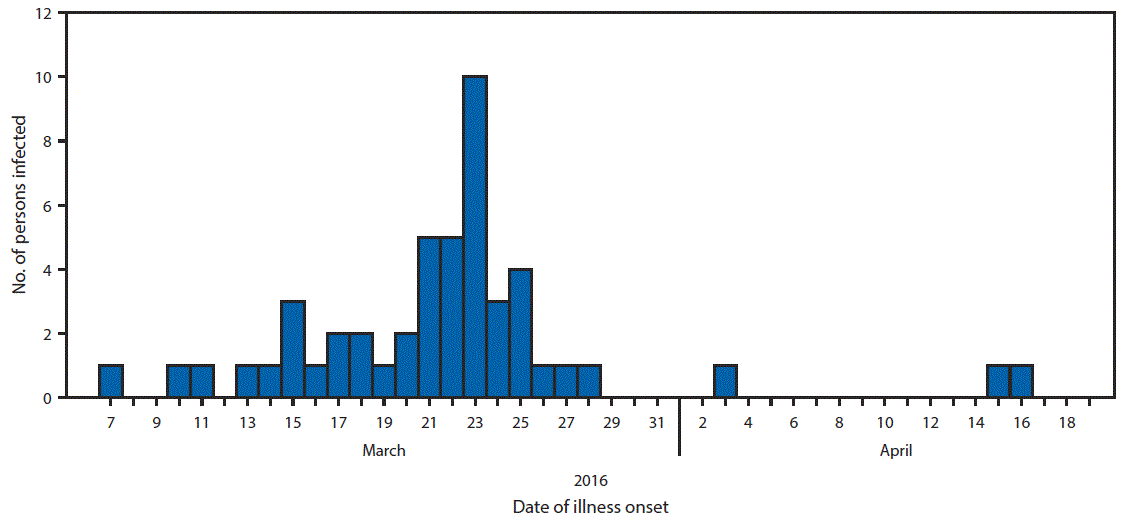 |
| MMWR Weekly Vol. 65, Nos. 50 & 51 December 30, 2016 |
| PDF of this issue |
Notes from the Field: Outbreak of Escherichia coli O157 Infections Associated with Goat Dairy Farm Visits — Connecticut, 2016
Weekly / December 30, 2016 / 65(5051);1453–1454
Mark Laughlin, DVM1,2; Kelly Gambino-Shirley, DVM1,2; Paul Gacek, MPH4; Quyen Phan, MPH4; Lauren Stevenson, MHS2; Alexandra Mercante, PhD2,3; Jocelyn Mullins, DVM, PhD4; Laura Burnworth, MPH2; Anna Blackstock, PhD2; Jafar H Razeq, PhD4; Matthew Cartter, MD4; Megin Nichols, DVM2 (View author affiliations)
View suggested citation
On March 24, 2016, the Connecticut Department of Public Health (DPH) identified a cluster of seven culture-confirmed Shiga toxin–producing Escherichia coli (STEC) infections in patients ranging in age from 2 to 25 years. All seven patients reported bloody diarrhea; four were evaluated in an emergency department, three were hospitalized, and two developed hemolytic uremic syndrome (HUS). Six of the seven patients reported visiting the same goat dairy farm in southeastern Connecticut during the week preceding illness onset. An investigation was initiated by DPH, the Connecticut Department of Agriculture, CDC, and the local health district to determine the magnitude of the outbreak, identify risk factors and potential sources of infection, and develop recommendations to prevent further illnesses. A total of 50 confirmed cases of E. coli infection were associated with the outbreak, including 47 with an epidemiologic link to the goat farm.
PulseNet, the national molecular subtyping laboratory network for foodborne disease surveillance, and pulsed-field gel electrophoresis (PFGE) were used to identify the outbreak strains as STEC O157. A confirmed case was defined as 1) laboratory-confirmed E. coli O157 infection with the PFGE-identified outbreak strain or 2) physician-diagnosed HUS during March–April 2016 in a person with an epidemiologic link to the goat farm. Ill farm visitors were encouraged to contact DPH through a public statement released on March 28, 2016, and were interviewed about their visit. Environmental samples were collected at the farm and cultured, and the resulting bacterial isolates were compared with patient isolates using PFGE and whole genome sequencing. Genetic relatedness of isolates was determined by high-quality single nucleotide polymorphism analysis. The 2013 Compendium of Measures to Prevent Disease Associated with Animals in Public Settings was used to evaluate practices at the farm (1).
An estimated 1,500 persons visited the farm during March 5–24, 2016, before a legal order was issued by the local health district to halt public visits. A total of 50 confirmed cases of STEC O157 were associated with the outbreak, including 40 (80%) in symptomatic persons who had visited the farm or had contact with goats from the farm, and six (12%) in persons who had contact with someone who had visited the farm. Of the 50 persons with confirmed cases, three did not have an epidemiologic link to the goat farm, and one had visited the farm but was asymptomatic (Figure). Median age of the patients was 5 years (range = 10 months–50 years). Eleven (22%) of the 50 persons were hospitalized, and three (6%) developed HUS.
Investigators obtained 61 environmental samples; among these, 28 (46%) yielded STEC O157. Sixteen of 17 fecal samples collected from goats yielded STEC O157. All environmental, fecal, and clinical isolates were indistinguishable from one another by PFGE and closely related genetically by whole genome sequencing (single nucleotide polymorphism range = 0–5). Facility design at the farm allowed for direct contact with goats and soiled bedding, and the farm did not have hand washing stations or signage to inform visitors of potential disease risks, as recommended by the Compendium (2).
This investigation highlights the risks to farm visitors, especially young children, from direct contact with animals such as goats and soiled animal bedding in the absence of infection prevention measures. The absence of hand washing stations might have contributed to the outbreak among farm visitors. Soap and clean running water should always be used to wash hands, which should be dried with clean towels immediately upon exiting areas containing animals (2). Because STEC O157 is known to colonize the gastrointestinal tract of healthy ruminants, including goats, which can then contaminate animal areas, standard procedures for cleaning and disinfection of exhibition areas, including equipment, should be adopted by animal contact venues to minimize the risks for exposure to STEC O157 (2). Facilities also might consider limiting access to potentially contaminated areas for persons at increased risk for severe STEC infections, including young children.
Corresponding author: Mark Laughlin, whz7@cdc.gov, 404-639-5272.
1Epidemic Intelligence Service, CDC; 2Division of Foodborne, Waterborne, and Environmental Diseases, National Center for Emerging and Zoonotic Infectious Diseases, CDC; 3Laboratory Leadership Service, CDC; 4Connecticut Department of Public Health.
References
- National Association of State Public Health Veterinarians Animal Contact Compendium Committee 2013. Compendium of measures to prevent disease associated with animals in public settings, 2013. J Am Vet Med Assoc 2013;243:1270–88. CrossRef PubMed
- CDC. Show me the science—how to wash your hands. Atlanta, GA: US Department of Health and Human Services, CDC; 2015. https://www.cdc.gov/handwashing/show-me-the-science-handwashing.html























.png)











No hay comentarios:
Publicar un comentario